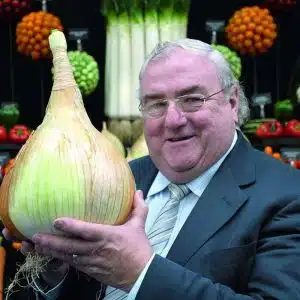Home - Moving On to the Leeks

Medwyn Williams
Hello. I'm Medwyn Williams – eleven times Gold medal winner at the Chelsea Flower Show, Past Chairman of the Royal Horticultural Society Fruit Vegetable and Herb Committee and President of the National Vegetable Society.
Moving On to the Leeks
As with the onions, the two raised beds that I grow my leeks in were thoroughly prepared during late October and November with plenty of well rotted manure being incorporated. During mid January some 4 ounces of lime was scattered on to the surface and this was well watered in with a sprinkler. When you are preparing beds early on in the year, under the protection of either glass or polythene, it’s important to ensure that the soil is never allowed to dry out.
Now that the onions were all planted up last week, it will be soon time to prepare the ground ready for the blanch leeks. They have grown really well so far and are now in their final pots which is a 2 litre rose type pot.
Collaring
For many years I used to collar my leeks in their pots, starting as early as when they were in the three inch pot and proceeding with longer collars as the plants grew on. What I did find by doing this was that the barrel of the leek was blanched much too early rendering them vulnerable to pest and disease invasion, particularly whilst still under lights in the greenhouse environment.
Plant Support Clips
I stopped doing this when I first bought my green plant support clips which are manufactured in two very useful sizes for encompassing a range of young plants. They are particularly excellent for leeks and onions helping the plants grow upright and erect. This means that a well looked after plant during it’s adolescent period will grow on to have all the meritorious attributes required from a potential winning set of leeks or onions.
Raised Beds
As with the onions, the two raised beds that I grow my leeks in were thoroughly prepared during late October and November with plenty of well rotted manure being incorporated. During mid January some 4 ounces of lime was scattered on to the surface and this was well watered in with a sprinkler. When you are preparing beds early on in the year, under the protection of either glass or polythene, it”s important to ensure that the soil is never allowed to dry out. During the dark dim days of winter it’s very easy to forget totally about the beds that you prepared during the back end of the previous year.
If the soil is allowed to dry out too much, then you will notice that when you come to prepare it during this month that the manure hasn’t broken down as well as you expected. Another problem, potentially far more serious with soil that has been allowed to dry out for good while under cover, is a lock up of salts within soil. When this happens it gives you a very high conductivity reading which means that some of the micro nutrients within your soil structure will not be able to function. To make sure that I never get to this position, I always maintain the moisture within the beds by using an oscillating sprinkler for few hours as soon as the soil is seen to be drying out.
Fertiliser
The fertiliser that I have used on the leek beds over the past two years has been a commercial type called Hydro Complex Partner which really worked well for me. It comes in quite large blue granules and releases an even balanced feed to the plants. I apply this evenly at 4 ounces to the square yard together with the same quantity of calcified seaweed. Both elements are then thoroughly worked into the soil by using my lightweight Honda rotovator. As my garden is now made up of as much as 80% raised beds, it is probably one of the most useful tools that I have ever used. It’s extremely powerful yet light and turns your soil into a beautiful texture in minutes, a function that would probably have taken you a couple of hours with a fork.
Moisture
The main difference in the preparation of the leek bed from the onion bed is that I do not use any seeping hoses neither do I use any black and white polythene. The main reason being that I prefer to water the leek beds by hand, that way I know that each bed has received sufficient moisture. Different to onions, I think leeks do need more moisture, you only have to consider the different structure of the foliage, the leek flags are much larger then the onion foliage, it therefore follows that there is a much larger area for transpiration. Another reason for not using the polythene is that you will not gain hardly anything by the added light being transferred from the polythene as the flags are much higher off the ground than the onion foliage.
Depth
When you plant out the leeks do take time to ensure that they are all planted to the same depth. This is very important when it comes time to harvest and exhibit them, even though they will have been grown on using exactly the same collar height. If each and every leek has not been planted to the same depth, then the length of the barrel from the root plate to the tight button is liable to differ considerably thereby giving you a problem in trying to match up a perfect set.
Pests and Disease
From now on it’s important to make sure that you have leeks free from any pest and disease. This sadly is getting more and more difficult to control as there are less products remaining on the market and even fewer new ones being released. The trouble with some of the pests are that all of a sudden you are faced with the result of their munchings, and the thrip in particular is very hard to eradicate once it gets established among the plants. The disease rust is very similar, once it’s there it can spread and cause havoc to your plants.
With rust a great deal can be achieved by looking out early for the small reddish pustules that can quickly spread from plant to plant. Make doubly sure as well that any stock leeks are clear from it, not only the foliage but also the stems as well. As soon as the pustules mature the will burst open and spread the spores on to other plants. Spraying on a regular basis with nothing more than diluted washing up liquid will build up a sheen on the flags that makes it far more difficult for the spores to congregate and establish – never forget the old saying ‘a stitch in time saves nine’
One pest that took me by surprise last year was the leek moth, before I knew it I had a major problem with the caterpillars munching their way through flags at an alarming rate. Do therefore keep your eye out for this menace, first for the moths flying around, then the eggs and afterward the green caterpillar that is sometimes difficult to spot being the same colour as the flags.
